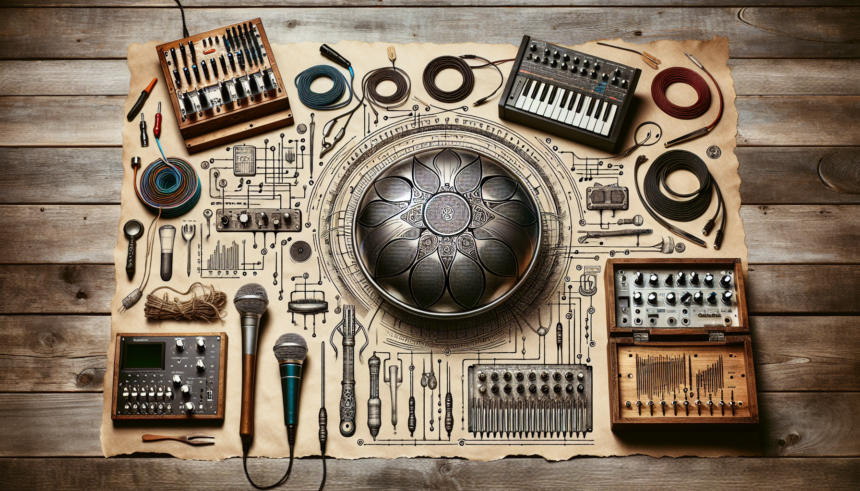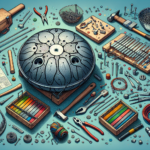<!DOCTYPE html>
<html lang="en">
<head>
<meta charset="UTF-8">
<meta name="viewport" content="width=device-width, initial-scale=1.0">
</head>
<body>
<header>
<h1>DIY Handpan Amplification: Building Your Own Setup</h1>
</header>
<article>
<section>
<p>The handpan is a captivating instrument known for its ethereal and soothing sounds. Musicians worldwide are drawn to its unique harmonic resonance and harmonic versatility. Recently, the demand for amplifying these instruments has grown, driven by performers seeking to share the enchanting sounds of the handpan with larger audiences in various environments. This article delves into the world of DIY handpan amplification, offering a comprehensive guide to building your own setup that enhances the sound quality while maintaining the instrument's natural acoustics.</p>
</section>
<section>
<h2>Understanding Handpan Characteristics</h2>
<p>Before diving into the amplification process, it's crucial to understand the unique characteristics of the handpan. Handpans are crafted from steel, usually with a series of notes hammered into the top surface. Each note, or tone field, has a fundamental tone, octave, and overtone, which collectively give the handpan its rich and layered sound. These nuances make amplification both challenging and rewarding, as maintaining clarity and purity is of utmost importance.</p>
</section>
<section>
<h2>Choosing the Right Microphones</h2>
<p>One of the foundational elements of any amplification setup is the microphone. The right microphone can accurately capture the handpan's harmonic richness. Here are some options:</p>
<ul>
<li><strong>Condenser Microphones:</strong> These are excellent for capturing subtle sound details and are a popular choice for recording handpans. Models like the AKG C414 or Neumann KM184 are well-suited for this purpose.</li>
<li><strong>Clip-On Microphones:</strong> Clip-on microphones provide flexibility and are less intrusive. Brands like DPA and Audio-Technica offer clip-on mics that can be mounted directly onto the handpan for live settings.</li>
<li><strong>Contact Microphones:</strong> These microphones capture the vibrations directly from the handpan's surface and are less affected by ambient noise. They are ideal for live performances in noisy environments.</li>
</ul>
</section>
<section>
<h2>Preamp Selection</h2>
<p>A preamp is crucial for boosting the low-level output signal from the microphone to a level suitable for further processing. Choosing the right preamp ensures that the captured sound remains clear and distortion-free.</p>
<ul>
<li><strong>Tubes vs. Solid State:</strong> Tube preamps can add warmth and character to the sound, while solid-state preamps offer clarity and transparency. The choice largely depends on personal preference.</li>
<li><strong>Multi-Channel Preamps:</strong> If you are using multiple microphones, consider a multi-channel preamp to simplify your setup and maintain consistency across all channels.</li>
</ul>
</section>
<section>
<h2>Acoustic Considerations</h2>
<p>When setting up your DIY amplification system, consider the acoustics of your performance space. The configuration can significantly affect the outcome:</p>
<ul>
<li><strong>Reflection and Absorption:</strong> Hard surfaces reflect sound, while softer surfaces absorb it. Understanding these effects can help optimize mic placement.</li>
<li><strong>Feedback Control:</strong> Be mindful of feedback rings during live performances. Use unidirectional microphones and ensure optimal microphone placement to minimize this issue.</li>
</ul>
</section>
<section>
<h2>Setting Up the Amplification System</h2>
<p>Once you have the right microphones and preamp, it’s time to connect everything to a mixer or audio interface, then to speakers or headphones for monitoring:</p>
<ol>
<li><strong>Connecting Microphones:</strong> Place your chosen microphones strategically around the handpan. For stereo image, use a pair of matched microphones to capture the full tonal spectrum.</li>
<li><strong>Mixer/Interface Setup:</strong> Connect each microphone to a dedicated channel on your mixer or audio interface. Adjust gain settings to prevent clipping while ensuring enough volume.</li>
<li><strong>Monitoring and Equalization:</strong> Use monitoring speakers or high-quality headphones to listen to your setup. Apply light equalization to enhance certain frequencies without sacrificing the natural sound of the handpan.</li>
</ol>
</section>
<section>
<h2>Recording Your Handpan</h2>
<p>Recording your amplified handpan performance can be an excellent way to capture the moment, whether for personal review, social media showcasing, or professional release:</p>
<ul>
<li><strong>DAW Setup:</strong> Use a Digital Audio Workstation (DAW) like Ableton Live, Pro Tools, or Logic Pro to record and edit your performance.</li>
<li><strong>Dynamic Range Processing:</strong> Consider applying compression to manage the dynamic range and ensure a balanced output that accommodates both soft and intense playing styles.</li>
<li><strong>Reverb and Effects:</strong> Add reverb and other effects sparingly to enhance the sound without overpowering the handpan's natural acoustics.</li>
</ul>
</section>
<section>
<h2>Troubleshooting Common Issues</h2>
<p>Amplifying a handpan can present unique challenges. Here are some common issues and their solutions:</p>
<ul>
<li><strong>Sound Distortion:</strong> Check the gain staging from microphone through to speakers. Ensure your preamp and mixer levels are set correctly.</li>
<li><strong>Feedback Loop:</strong> Position microphones at an adequate distance from speakers. Use digital feedback elimination tools if necessary.</li>
<li><strong>Microphone Hum:</strong> This can often be corrected by ensuring all connections are secure and using balanced cables.</li>
<li><strong>Uneven Sound Distribution:</strong> Experiment with microphone placement and equalization to achieve a well-balanced sound.</li>
</ul>
</section>
<section>
<h2>Conclusion</h2>
<p>Building your own handpan amplification setup can be a fulfilling process, tailored to produce the best sound possible for your unique instrument and environment. By carefully selecting equipment that suits the handpan’s delicate tones, strategically configuring your setup, and learning to troubleshoot common issues, you can create an effective amplification system that enhances your performance. With practice and patience, you can share the enchanting sounds of the handpan with a wider audience, enriching their experience and deepening your connection with this beautiful instrument.</p>
</section>
<section>
<h2>FAQs</h2>
<h3>1. What is the best microphone for handpan amplification?</h3>
<p>Condenser microphones like the AKG C414 are popular due to their sensitivity and ability to capture subtle nuances, but clip-on or contact microphones may be preferred for live settings.</p>
<h3>2. Do I need a preamp for my handpan amplification setup?</h3>
<p>Yes, a preamp is recommended to boost the microphone signals to line level, ensuring clear and distortion-free sound reproduction.</p>
<h3>3. How can I avoid feedback in a live setup?</h3>
<p>Use unidirectional microphones, ensure proper microphone placement, and carefully manage gain levels to reduce feedback risk.</p>
<h3>4. Can I use effects with my handpan amplification?</h3>
<p>Yes, effects like reverb can enhance your sound, but use them sparingly to avoid drowning out the instrument’s natural tones.</p>
<h3>5. Are there specific DAWs recommended for handpan recording?</h3>
<p>Any DAW like Ableton Live, Pro Tools, or Logic Pro can work well for recording handpans. Choose one based on your preference and familiarity.</p>
</section>
</article>
</body>
</html>DIY Handpan Amplification: Building Your Own Setup

Leave a comment




